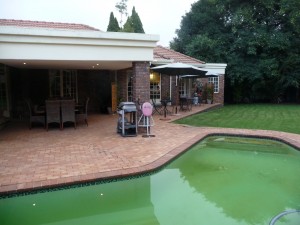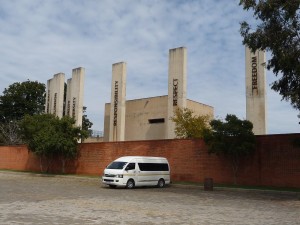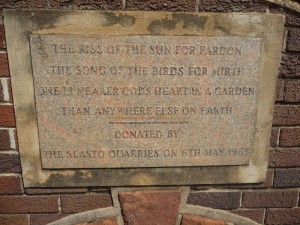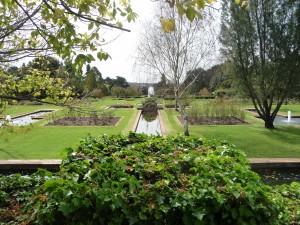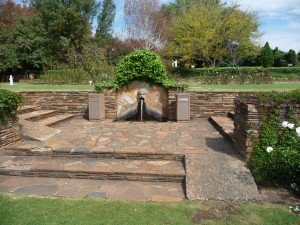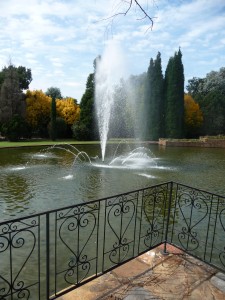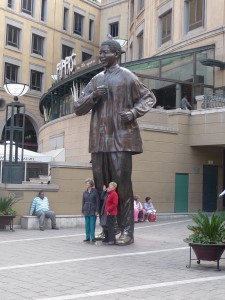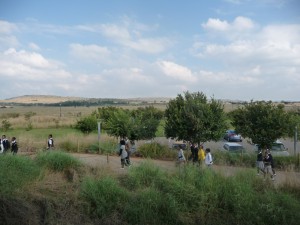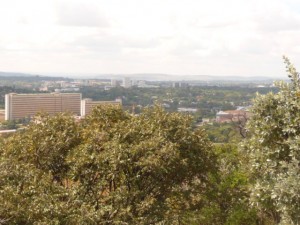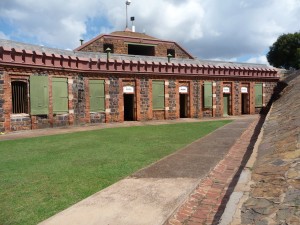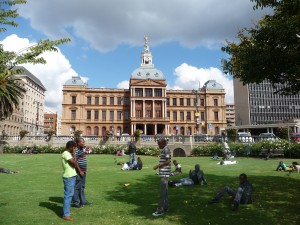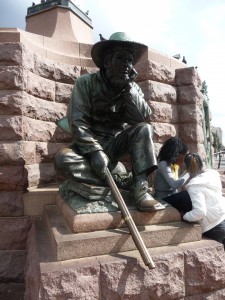I landed in Johannesburg (Jo-burg is what they call it themselves) on Monday late in the afternoon. My first challenge was the car. They drive on the left here, but I had already got used to that in New Zealand and Australia. The new complication was driving a standard. Automatics are much more expensive to rent in South Africa and Europe, so I am saving money by going with the stickshift – a stickshift on the left hand side of course! The last time I drove a standard (I think) was my Celica, which I sold in 1984. Okay, so now you can imagine the first couple of hours of driving were pretty hard on the car. But then I got used to it and the rest of the week was fine.
I stayed at the Great Stays Guesthouse, a four room (soon to be five) residence near the airport that is just simply beautiful. I stayed in room 4 and it was charming with a nice yard and garden to look out on.The owner, Ronnie, is a very pleasant conversationalist.
Observations as a tourist
I do have to say that if you are coming to South Africa as a tourist hoping to see lots of interesting sites, Jo-burg is not the place to go. There isn’t much here to see. That’s not just my opinion, because the people who live here think so too.
The most significant thing to see in Jo-burg would be the Apartheid Museum. I tried to see this on Friday, but it was closed. I was warned that after seeing it most people are very upset, angry and sometimes even distraught, because apartheid was about a lot more than just separation. Even the white people here will tell you how awful it was. The average white person had no idea back then what the real experience of the black people was. They knew they were poor, but otherwise thought they just lived segregated lives. They say they did not understand all the social, legal and power-based systems that kept the black population in such abject circumstances as they endured.
But as I say, the museum was closed the one day I had a chance to see it, so I went instead to the Botanical Gardens and enjoyed some of God’s beautiful creation on Good Friday and then went to see the huge statue of Nelson Mandela.
I did not want to tour Soweto, which seems to be what the guidebooks want everyone to do, because I had felt such a voyeur while touring the Leprosy Mission hospital in Kolkata. The Leprosy Mission is doing a great job, and they can be justly proud of their work, and they naturally want their story to be told by as many people as possible, so I understand their willingness to show the hospitals, but I have a hang-up because I felt like the patients’ pain and suffering was cheapened as a tourist attraction and that I was invading the patients’ lives for the sake of my curiosity. As I posted earlier, both the patients and I exchanged greetings one-on-one, and the Leprosy Mission is doing fantastic work for their benefit (taking the tour did give me a chance to see the obviously very warm relationship the hospital staff and patients have with each other), and now I can promote their good work, but even though the patients welcomed my interest, I still have that lingering feeling that I shouldn’t invade their suffering. So I didn’t go to Soweto.
There is The Cradle of Humanity about an hour north of the city, but there certainly isn’t much there. I was out that way for a visit, so I continued on to the main cave where there is a short tour available. They don’t actually let you see much, but you can see a few fossils. Well, I went to pay my entrance fee, and what did I see? A sign that says to tour the caves you have to both squat and crawl on your belly. Hmm. That suggests tight spaces! I think there is a bit too much of me to risk getting stuck in a cave!! Also, they talked about claustrophobia being a problem for people. I don’t think I have claustrophobia, but I got the general picture of what the experience would be like and decided to pass on it. Also, I wasn’t dressed to crawl because I had been at a couple of meetings. There is a small museum there, so I paid to visit that. So it turned out to be mostly just a nice drive in the country.
Except…that the highway to get there has lots of stoplights, and if there is a stoplight anywhere in the Jo-burg area, there will be beggars and hawkers there approaching every car with the most innovative stories of poverty and the most ordinary of products. That I got tired of real fast. However, on the plus side, these street workers are the most polite beggars and hawkers I’ve run across yet. Indians just never give up. They will follow you for several hundred feet negotiating themselves down to almost nothing just to get a sale. I guess they think “No thank you, I’m not interested,” and “I don’t want it and I won’t buy it, ever!” are just negotiating ploys. But in South Africa, you can just say “No thanks” and they will move on without comment.
I drove up to Pretoria for one meeting and on the way saw a sign for a Boer fort, so I drove up the high hill and got a wonderful view of Pretoria and a short walk through the fort.
I went to the main square in the city because there are some interesting buildings there.
When I turned into the square, immediately four fellows started vigorously waving me to a parking spot. They went in relays sprinting ahead, scouting out where there was an open spot. I didn’t know if they were employed by the city as parking guides or not (after all, the square was very congested), but it turned out they were competitors to the city. Rather than put money in the parking meter, they will watch your car for you (so they say) and they will look after it if a parking officer comes along. What to do? I finally paid them some money and started to leave, but then one of them wanted more money for something I couldn’t understand. I asked the leader, “is this guy with you or not? I’ve already paid you.” He said he was part of the group but he was trying to get additional business for himself. So I just ignored him.
Another guy wanted money to wash my car (any South African public parking lot I went to had people who wanted to wash my car!), but I said under no circumstances did I want my car washed. I walked once around the square, but you can’t actually go in the buildings, so other than seeing the facades, I didn’t really do any sight-seeing there. I also didn’t want to leave the car too long. So after fifteen minutes or so, I went back to my car. A guy asked me for money for washing it and I said “NO! I already said I wouldn’t pay for that.” He was upset and said “But I already washed it!” I didn’t know if he had or not, but I didn’t care. I just replied, “Too bad.” Really, this is so tiresome and annoying. Non-stop.
Ministry visits
I met the most delightful people this week. They were:
– Credo Mangayi, Deeds of Love Ministries Director for the Baptist Union;
– Martin De Lange, Director of Resource Development for Operation Mobilization;
– Thomas Resane, pastor of Assembly of God Church and former long time executive director of Youth For Christ.
I feel I must say something here. Once again, I am referring to a Pentecostal church. I am ordained by the PAOC, so it would be natural to think I played favourites in picking people to see. But I didn’t. Most of the times when I have referred to Pentecostal or PAOC ministries, I did not know of the connection (eg., The Wellspring Foundation) or even the existence of the ministry (eg. I only knew Thomas as the former E.D. of Youth for Christ). I had lots of contact with Mennonite, Baptist and other denominationally-affiliated ministries, but for one reason or another they could not see me. In Nairobi, I would have gone to any church that was within walking distance, but the only one, by a long shot, was the Pentecostal one. Maybe I’m just hypersensitive, but I’ve been quite aware of the apparent bias in my visits.
– Mark Tittley, Youth Pastor at His People Christian Church (there! an independent church);
-John Abrahamse, J-Life Ministries (training next generation leaders);
-Buhle and Stacey Dlamini, Salvation Army members and owners of Young and Able, a training business that works closely with churches and ministries;
-Colleen Walter, founder of Safe and Sound Learning Association, which has trained 150 women at 100 schools how to teach children well. These schools wouldn’t otherwise have trained teachers, which would make the chances of their getting continued higher education almost negligible;
– Moss Nthla, director of the Evangelical Alliance of South Africa; and
-Manfred Molomo, long-time National Director of The Navigators, and now working to provide administrative support to several Christian ministries.
I find it offensive to classify people by race, but race is so important here that they do it all the time, and I discovered that you can’t make sense of anything in South Africa unless you do refer to race. South Africans are not one people. They are a least three separate peoples, each with their own history and culture, who are now trying to live together in peace. They can’t pretend they are all one because they aren’t. It is only by acknowledging their race and all that race implies that they can have any meaningful relationship with each other.
I met with self-described black, coloured, white English and white Afrikaaner people. There is one more category that I didn’t meet a representative of, Indian. What was interesting was that no matter which race was talking to me, they all agreed on their portrayal of the different races. For example, my black friends described how blacks give donations exactly the same way white friends described how blacks give. And the same in reverse. It seems everyone now understands each other and when they talk about their history, culture and current attitudes, all races are on the same page. The relevance of race is that the solutions to various problems will be different according to which race you are talking about. So they said many things to me that made me wince because if I said them in Canada, they’d be so politically incorrect that there’d be a hue and cry for my resignation! But here, you can’t have a constructive conversation about any issue without referring to race.
Manfred Molomo was really inspiring to me. He was born in a village 300 miles north of Jo-burg that had no electricity and no running water. It was as poverty-stricken an area as anywhere in South Africa. He attended a school that had a building and books, but no teachers. The only education you got there was self-taught. Not many were able to do that. Okay, so you have probably guessed Manfred’s race now without my saying it. He knew if he was going to make anything of himself he would need to know math, so he concentrated on learning math. He did so well at it that he was admitted to a university. He lived in a township and commuted 3 hours a day. At the end of the first term, he was the top student and he won a full scholarship that included a dorm room. He was the first person ever from his village to earn a degree. He was hired by a major international accounting firm and the rest is history. He did all this during the days of apartheid, but both the government and business knew the days were limited and they were trying hard to show the world that there was opportunity for blacks.
His village now has electricity and a water tap for every street, but it is still poverty-stricken. His father still lives in the village, and I thought he must marvel at the life his son now leads and the beautiful house he lives in (we met at his house).
But Manfred is the exception. Not much has changed for most blacks except that everything has been desegregated and they can vote. The real work is still to begin. For example, while all races now go to school together, the curriculum hasn’t been adjusted yet, so there are systemic learning problems for blacks that are completely unrelated to their ability to learn.
Although there is much yet to be done, we do need to appreciate how far South Africa has come since 1994. I saw blacks and whites together everywhere. I saw many mixed race couples and met some people who are in mixed marriages. I saw many blacks in key leadership roles and I saw many whites serving blacks in restaurants. At least in the two cities I visited, the races really are getting along together.
It is the ability to share a community in common that I think holds the best promise for an even brighter future for South Africa.

